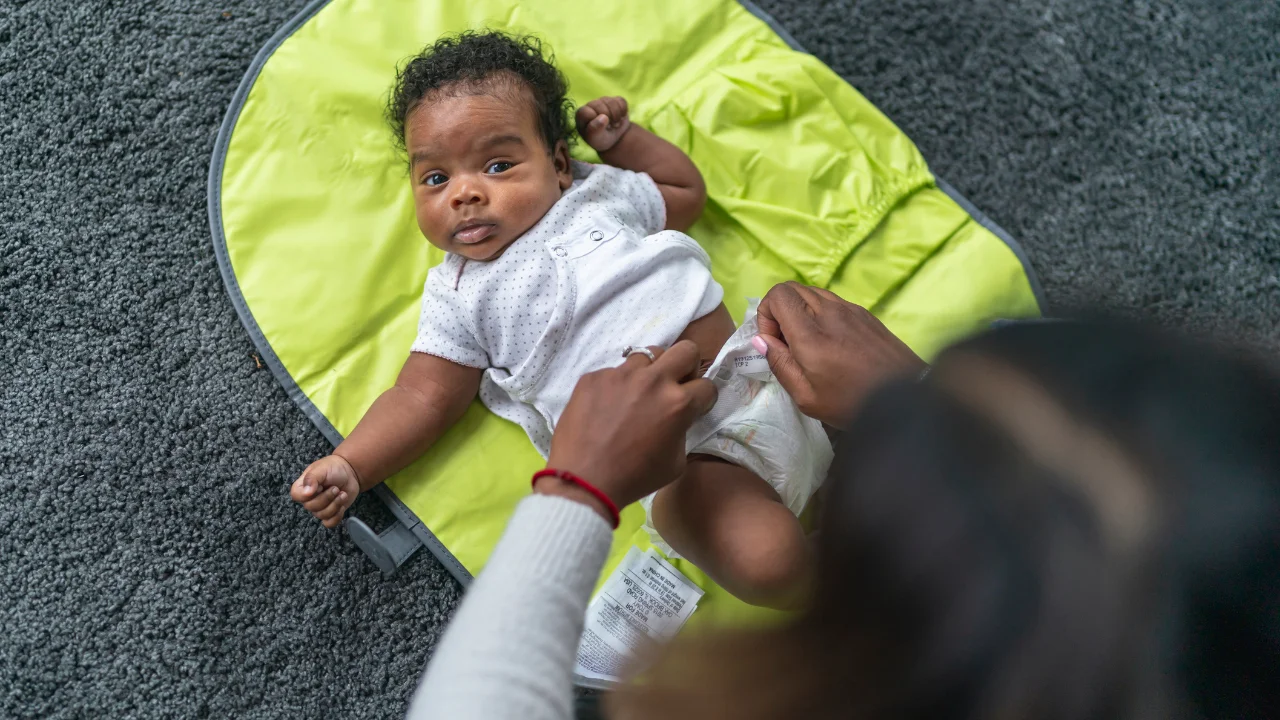
IN THIS ARTICLE
- What should baby poop look like?
- Newborn poop (meconium)
- Breastfed baby poop
- Formula-fed baby poop
- Iron-fortified baby poop
- Solid food baby stool
- Baby stool with partially digested food
- Baby diarrhea
- Constipated baby poop
- Baby poop with mucus
- Blood in baby’s poop
- Chalky or white baby poop
Colors and textures. Baby poop comes in a variety of colors, and those colors can change depending on your baby’s diet. Your newborn’s very first poop, called meconium, is greenish-black and tarry. Breastfed poop is yellowish, soft, and seedy; while formula-fed poop is thicker and brownish in color. Solid food poop has more substance and a stronger odor. Babies can be constipated and have diarrhea, just like adults, which will make their poop look different than usual. These photos give you the full scoop on newborn poop. (A note for the squeamish: This gallery contains real photos.)
What should baby poop look like?
Baby poop comes in a wide range of colors and textures variety, and deciphering what’s normal and what’s not can be puzzling to a new parent. If you’re spending more time than you’d ever imagined staring quizzically at the contents of your baby’s diaper, you’re not alone! Bowel movements are one of the most common concerns parents ask their child’s doctor about.
This baby poop chart will give you the full scoop on your newborn’s bowel movements. The following photos and information will help you understand which baby poop colors are normal and which ones warrant a call to the doctor as your newborn grows, drinks breast milk or formula, and starts eating solids. You’ll find out what’s harmless, and when there may be a cause for concern.
If you still have questions about your baby’s bowel movements after reading this guide, don’t hesitate to call or email photos of any questionable baby stools to your child’s provider.
Note: These are pictures of real baby poop! Please view only if you’re comfortable looking at them.

Newborn poop (meconium)
You may be surprised to learn that normal newborn poop doesn’t look very normal at all. For your baby’s first couple of bowel movements, expect to find a greenish-black, tarry, sticky sludge that kind of looks like motor oil when you open your newborn’s diaper. Since meconium is made of mucus, amniotic fluid, dead cells, and other stuff your baby ingested in utero, it doesn’t really smell – so you may not realize it’s time for a diaper change.
When your baby is 2 to 4 days old, their poop will become lighter in color – sort of a yellowish green – and less sticky. This so-called transitional stool is a sign that they’ve started digesting early breast milk or formula and their intestinal tract is working just fine.

Breastfed baby poop
Normal breastfed baby poop, like as seen in this photo, is yellow or slightly green, and has a mushy or creamy consistency. It may be runny enough to resemble diarrhea, though baby diarrhea is usually very liquid in consistency. Breastfed poop typically looks like Dijon mustard and may be dotted with little seed-like flecks. Interestingly, it smells slightly sweet.
There are many shades of normal when it comes to breastfed baby poop. One you might see is a greener tone, which could signify that you ate something different than you normally do. If your baby isn’t experiencing any other symptoms, there’s no need to worry.
If you see bright green and frothy poop in your baby’s diaper that almost looks like algae, they’re probably getting too much foremilk – the low-calorie milk that comes first in a feeding – and not enough hindmilk, the higher-fat, super-nutritious stuff that comes near the end. It could mean that you’re not feeding your baby long enough on each breast. To remedy this, start each new breastfeeding session on the breast you ended on the last time.

Formula-fed baby poop
Formula-fed babies have thick, pasty, peanut butter-like poop on the brown color spectrum. Its color ranges from tan-brown to yellow-brown or even greenish-brown.
The thicker consistency of formula is slightly harder to digest than breast milk, so some of its ingredients end up passing right through your baby’s digestive system. Formula-fed baby poop is also more pungent than poop from breastfed babies, yet a little less pungent than poop from babies who are eating solid food, but you’ll recognize the smell.
If at some point you decide to switch formula brands, expect the look – and feel – of your baby’s poop to change. Its aroma might change, too.

Iron-fortified baby poop
Green baby poop is a sign of iron in your baby’s formula. The iron in formula doesn’t absorb as well as the iron in breast milk – hence the greenish hue. If you give your baby an iron supplement, their poop may turn dark green or almost black. This doesn’t happen often, but it’s normal.
One thing: If your baby’s poop looks blackish and they’re not taking an iron supplement, it’s a good idea to call their doctor. Rarely, blood in infant stool can turn poop a black color, which is called melena. Your child’s doctor can make sure there’s no stomach bleeding to worry about.

Solid food baby stool
Once you start introducing your baby to solid foods – infant cereal, pureed bananas, and so on – you’ll almost instantly notice a change in their output, especially if your baby is breastfed. Solid-food poop tends to be brown or dark brown and thicker than peanut butter, but still mushy. Get ready: It’s also much smellier than exclusively breastfed poop.
Expect the consistency of your baby’s poop to change depending on what they’ve recently eaten. Some bowel movements may look hard and pebble-like, while others can have that runny, mustard-like consistency of breastfed poops. There’s nothing to worry about unless your baby seems to be straining or goes more than a few days without going at all.

Baby stool with partially digested food
Occasionally your baby’s poop will have identifiable chunks of food in it or be tinged with a surprising hue of the rainbow, like red, orange, or dark blue – this isn’t something you need to worry about. Red could mean beets, orange suggests carrots, and dark blue implies blueberries (you may even see tiny pieces of blueberry skin in there, too).
You’re likely seeing this because certain foods are only partially digestible or travel so quickly through the intestines that they don’t have time to completely break down. It also happens when your baby eats a lot of one food or doesn’t chew a mouthful completely before they swallow.
The time to call the doctor is if your baby’s poop consistently has undigested food in it. Your baby’s doctor will check to make sure their intestines are properly absorbing food and nutrients.

Baby diarrhea
Newborn diarrhea is very runny and looks like it’s made up of more water than solid food. It can be yellow, green, or brown, and often can seep or “explode” out of their diaper.
Diarrhea can be a sign of an infection or allergy. If it lasts for a while without being treated, it can lead to dehydration. Call the doctor if your baby:
- Has signs of dehydration, such as crying without tears, dry lips, peeing less often than usual, or excess sleepiness
- Has diarrhea that doesn’t go away after a few days
- Has visible blood or mucus in their diarrhea
- Has a fever along with the diarrhea

Constipated baby poop
If your baby’s poop is hard and looks like little pebbles, they’re probably constipated. Your baby may look visibly uncomfortable when they’re pooping, and the poop may be tinged with blood from irritating the anus on the way out. One or two pebbly diapers isn’t a concern, but if the constipation doesn’t improve, your baby is irritable, or you see blood in their stool, it’s best to call their doctor.
Constipation often happens in babies who are being introduced to solid foods, or it can be a sign that your baby isn’t getting enough fiber in their diet. Your doctor may recommend giving your baby water, pear, or prune juice to help move things along.

Baby poop with mucus
Does your baby’s diaper look like it’s been slimed? Greenish poop streaked with shiny, glistening strings means there’s mucus in it. This sometimes happens when a baby is especially drooly, since mucus in saliva often goes undigested. Drooling can be a sign that a tooth is about to pop.
Mucus in poop can also be a telltale sign of an infection or food allergy. Rarely, it could mean your baby isn’t absorbing enough nutrients from breast milk or formula. If the mucus is accompanied by any other symptoms (such as diarrhea or a fever) or it shows up in your baby’s diaper for two days or more, call their doctor to rule out any problems.

Blood in baby’s poop
Seeing red in your baby’s diaper can be frightening, to say the least. Many of the possible causes of blood in baby stool aren’t serious, like small tears in the baby’s anus from passing large poops, or a cow’s milk allergy. (Despite its name, a cow’s milk allergy is more of an intolerance, and most babies grow out of this by age 1. It will require you eliminating cow’s milk from your diet, if you’re breastfeeding, or switching your baby to a formula without cow’s milk.)
Sometimes the blood in infant stool is bright red from bleeding closer to the surface, and sometimes it’s black (which means it’s been digested). Sometimes, red dye in food or medication can also turn stool slightly red.
Call your doctor if you notice:
- Normal poop tinged with red blood, which is often a sign of a cow’s milk allergy
- Constipated poop with a hint of red blood, likely a result of tears in the anus or hemorrhoids
- Diarrhea mixed with red blood, which can signal a bacterial infection
When black blood appears in a baby’s diaper – usually in little flecks that look like black poppy or sesame seeds – it’s often because your baby is breastfed and swallowing blood from your cracked and bleeding nipples. While this is a sign that you need some pain relief, it doesn’t pose a threat to your baby. Still, it’s best to call your baby’s doctor to make sure it’s not something more serious, like bleeding from their intestines.

Chalky or white baby poop
Lots of seemingly frightening signs in your newborn’s poop are nothing to worry about. Others, like white, grey, or pale-yellow stools, are good reason for concern. Pale stools can be a sign of biliary atresia – a blockage in the tubes that carry bile from the liver to the gallbladder. Bile is the greenish fluid that helps us digest food and gives poop its brown color.
If your baby’s stool looks especially pale, call their doctor right away. Biliary atresia is rare, but babies diagnosed with it need surgery to fix the blockage. The procedure works best when it’s done before a baby reaches the 2-month mark.

Read more about


Add a Comment